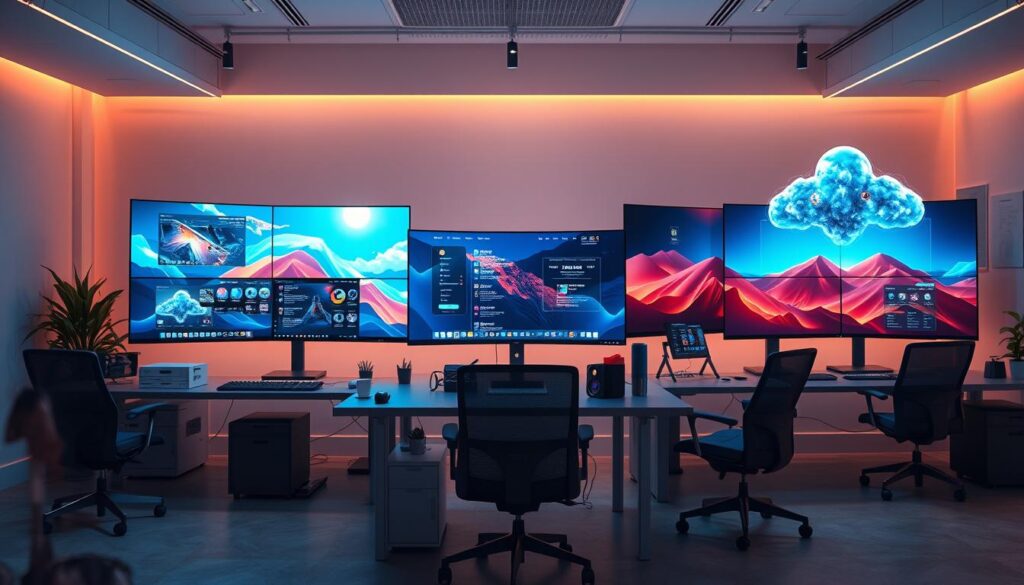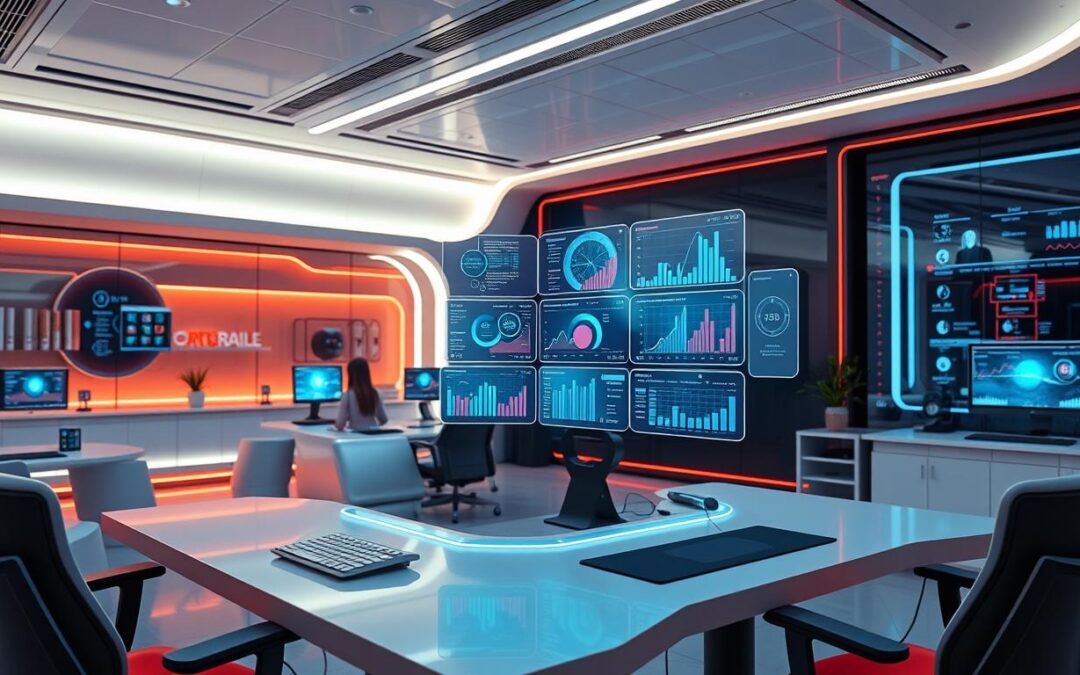A virtual desktop is like a digital version of your real desktop. It lets you work from anywhere with just an internet connection. This tech has changed how we work, making it easier to access your desktop from anywhere.
With a virtual desktop, you can get to your files and apps from any device, anytime. It’s perfect for companies with remote teams or those who work from different places. It helps employees work from anywhere, making work more flexible and efficient.
Using virtual desktops can save a lot of money on computer upkeep. You can use less powerful devices, which is cheaper. Plus, it makes your data safer by keeping it on servers, not on your computer.
Key Takeaways
- Virtual desktops provide remote access and flexibility, enabling work from any location with an internet connection.
- Virtual desktop solutions, such as virtual desktop, remote desktop, and cloud desktop, increase workforce agility and productivity.
- Implementing virtual desktops can lead to significant cost savings related to hardware maintenance and upgrades.
- Virtual desktops enhance data security by keeping sensitive information on centralized servers.
- Leading virtual desktop solutions offer essential features such as instant provisioning and scalability, making them an ideal solution for businesses.
Understanding Virtual Desktop Technology
Virtual desktop infrastructure (VDI) lets users access a virtual desktop from any device, anywhere. It combines virtual desktop services and solutions for this experience. To grasp how VDI works, we need to look at its main parts.
A virtual desktop has two key parts: the control plane and the data plane. The control plane handles resources and policies. The data plane delivers the virtual desktop to the user’s device. This setup makes VDI flexible and scalable.
What is a Virtual Desktop?
A virtual desktop is like a digital version of a real desktop. It runs on a remote server. This lets users access their desktop from any device, without being tied to one machine. Virtual desktop solutions offer many benefits, like more flexibility and cost savings.
Key Components of Virtual Desktop Infrastructure
The main parts of VDI include the control plane, data plane, and hypervisor. The hypervisor manages virtual machines and resources like CPU and RAM. This setup helps IT run more virtual machines on fewer physical servers.
Evolution of Desktop Virtualization
Desktop virtualization has grown a lot, leading to new solutions and services. These advancements have made it easier for businesses to use virtual desktops. Many companies have seen better flexibility, productivity, and cost savings. As technology keeps improving, we’ll see even more innovative virtual desktop options.
Benefits of Virtual Desktop Solutions for Modern Businesses
Virtual desktop solutions bring many benefits to modern businesses, especially those with remote workers or multiple locations. They enhance security and data protection. They also improve accessibility and flexibility. Plus, they make IT management and support easier and cut costs. Virtual desktop software helps manage virtual desktops from one place, making setup and upkeep simpler.
Some key benefits of virtual desktop solutions include:
- Improved productivity: Businesses see a 30% boost in productivity thanks to better accessibility and flexibility.
- Cost savings: Companies save 30% to 40% on IT costs, mainly by needing less hardware.
- Enhanced security: Switching to virtual desktops can cut security incidents by 50%, thanks to better management and security.
Virtual desktop solutions also help businesses adapt to changing employee needs. They make it easier to manage the workforce without spending too much on hardware. With desktop virtualization, companies can also cut their carbon footprint by up to 20%. This is because they use less physical infrastructure and energy. Adopting virtual desktop software makes businesses more flexible, secure, and productive, making it a great choice for today’s organizations.
Essential Features of Virtual Desktop Infrastructure
When setting up virtual desktop infrastructure, it’s key to think about the must-have features. A top-notch virtual desktop solution should let IT admins manage all virtual desktops from one place. This makes it easy to adjust resources and scale as needed.
A secure virtual desktop is crucial, with features like detailed controls and easy profile and data management. It’s also important to consider how users will experience the desktop. This includes customization options and how well it works with current systems. A secure and customizable virtual desktop boosts productivity and flexibility.

- Centralized management and maintenance
- Resource allocation and scaling
- Customization options for users
- Integration with existing systems
- Granular controls for security
By adding these features, businesses can build a top virtual desktop environment. This environment meets their specific needs and boosts productivity.
Security Measures in Virtual Desktop Environments
Keeping virtual desktop security top-notch is crucial for companies. It’s all about protecting sensitive data and keeping business running smoothly. To do this, firms use things like multi-factor authentication, strict access controls, and encryption.
Centralizing security is a big part of virtual desktop security. It makes managing and protecting virtual desktops easier and more effective. This includes secure data storage and regular updates to keep everything safe. With these steps, companies can lower the chance of security issues and data loss.
- Less chance of security breaches and data loss
- Meets regulatory needs better
- Keeps sensitive data and ideas safe
- Makes managing security easier and more efficient
By focusing on virtual desktop security and using good virtual desktop protection methods, companies can have a safe and reliable virtual desktop setup. This setup supports their business and keeps their assets safe.
Implementing Virtual Desktop Solutions
Implementing virtual desktop solutions needs careful planning for a smooth transition. You must assess your business’s needs and develop a detailed deployment strategy. A well-planned virtual desktop implementation can cut costs, boost efficiency, and enhance productivity.
When deploying virtual desktops, consider user load, internet capacity, and data center resources. Choose the right hypervisor and think about security, like two-factor authentication. A thorough approach to virtual desktop implementation ensures technology resources are used wisely and reduces downtime risks.
For a successful virtual desktop deployment, focus on user training and adoption. Provide users with the tools and resources they need. Offer ongoing support and feedback. Engaging with users and stakeholders ensures a smooth transition and maximizes benefits.
Benefits of virtual desktop implementation include:
- Improved security and efficiency
- Increased flexibility and scalability
- Enhanced user experience and productivity
- Reduced costs and improved resource allocation
Cost Considerations and ROI Analysis
When looking at virtual desktop solutions, it’s key to think about the virtual desktop costs and ROI. You need to balance the upfront costs, like hardware and software, with ongoing expenses like maintenance and support.
The virtual desktop ROI can be quite high. Businesses can save on hardware costs and make maintenance easier. Azure Virtual Desktop costs come from Azure resource use and licensing. Licensing costs must be paid upfront, and VM instances are the biggest expense.
When figuring out virtual desktop costs, consider these points:
- Compute, storage, and networking costs for domain controller VMs
- Costs for using Microsoft Entra ID with Active Directory Domain Services
- Using autoscale to control costs by adjusting session hosts based on demand
By understanding these points and using tools like the Azure Pricing Calculator, businesses can make smart choices. They can optimize their virtual desktop ROI and cut down on expenses.

Best Practices for Virtual Desktop Management
Effective virtual desktop management is key for better performance and security. By following virtual desktop best practices, businesses can make connections smoother, cut costs, and boost user happiness. It’s important to keep an eye on things and fix problems fast.
Important steps for virtual desktop management include managing everything from one place, training users, and keeping things secure. These virtual desktop best practices help companies work better, use resources wisely, and make users happier.
Also, using tools like Azure Virtual Desktop can make virtual desktop management easier and more efficient. By following these virtual desktop best practices, companies can lead the way and get the most out of their virtual desktop setup.
Overcoming Common Virtual Desktop Challenges
Virtual desktops bring many benefits but also face challenges. One big issue is improving performance. Businesses can use data compression and caching to make things run better.
Another key area is virtual desktop troubleshooting. Having clear guidelines helps solve problems fast. This way, users can keep working without interruptions. Common problems include network issues, gateway problems, and misconfigurations.
To tackle these issues, businesses can:
- Start monitoring and optimizing regularly
- Use tools like Nerdio Manager or Azure Resource Monitor for accurate status tracking of session hosts
- Follow least-privilege access policies to balance security and work needs
By tackling these virtual desktop challenges and using good virtual desktop troubleshooting methods, businesses can make sure users have a great experience. This leads to success in today’s digital world.
Conclusion: The Future of Virtual Desktops in the Digital Workplace
The digital world is changing fast, and virtual desktops are at the forefront. With more people working from home, the need for flexible and safe computing access is clear. Virtual desktops and remote desktops are key to making this shift work, helping businesses stay ahead.
New tech like cloud computing, 5G, and edge computing will make virtual desktops even better. AI and ML will make managing virtual desktops smarter, offering insights and automating tasks. Security will also get a boost, with better ways to keep data safe.
Looking ahead, companies that adopt these virtual desktop trends will gain a lot. They’ll see better productivity, flexibility, and strength. Virtual desktops will empower workers, make IT easier, and keep businesses competitive in the digital world.

